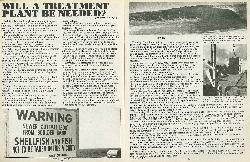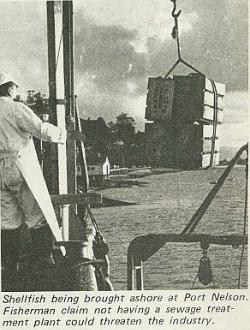33
Tests
The City Council did not open the new system and just let it go at that. Regular tests of sewage, sea water and shellfish at eight points, up to about three miles from the Boulder Bank, are taken to comply with Nelson Catchment Board requirements to operate an outfall. Tests are also made of sludge, when sea conditions permit, to ascertain any build-up. A difficulty with tests for bacteria harmful to public health is that there are no standards on which to assess the acceptable degree of bacterial content in shellfish.
In an interview with Nelson's Christchurch Press staff reporter Barry Simpson, the director of the Cawthron Institute, Dr R. H. Thornton, said it was time the authorities laid down a set of standards for New Zealand. Tight control existed for export produce, but not for home consumption.
The Cawthron Institute analyses tests from the outfall. Initially the bacteria count on shellfish samples increased (before the sewage was discharged there was no count) but the figures remained fairly static until a high count of 350 was shown in February at one of the inner test points, 5000ft from shore. It was this relatively high bacterial count which led to the Catchment Board's recommendation to close an area to commercial fishermen.
In Mr Simpson's article in The Press, it is stated: "The emergency of positive results from research work being conducted by another institute (Cawthron) scientist, Dr M. B. Cooke, is disturbing both Dr Cooke and Dr Thornton. Dr Cooke, who specialises in bacteriology, has been researching the incidence of antibiotic resistance to coliform bacteria in polluted waters."
"She has discovered already that high numbers of bacteria, present in water taken from an area close to the sewer outfall, are resistant to several antibiotics. She is also examining the ability of those bacteria to transfer this resistance to other bacteria."
"Presumably, if the Catchment Board wants an area cordoned off, then is not this tantamount to saying that the pollution problem has increased to the stage where the consumer has to be given protection?" said Dr Thornton. "I Cannot See That In This Day And Age We Should Be Dumping Raw Sewage Into The Sea, Relatively Close To A Well Populated Area."
There is no evidence that the shellfish beds most fished are polluted, but scallops do shift. And what is to stop them from nipping into the polluted area, eating up large and growing big, and then wandering back into the fishing area?
How does the average citizen protest about pollution? Well, the Minister of that relatively new portfolio, the Environment, Mr Maclntyre says: "Any citizen can report a case of water pollution to his regional water board in the knowledge that immediate and effective action can be taken."
In Nelson, the Nelson Catchment Board is the regional water board and is prepared to discuss any pollution problems and investigate complaints.
Mr Maclntyre also says: "Preventing water pollution is now in the hands of the people most concerned — those who use or enjoy our natural waters. The machinery is there — it is up to them to use it."
And the Nelson M.P., Mr Stan Whitehead, said, "There is nothing to stop people writing direct to the Minister of the Environment. But should they choose to use me as the avenue of object, I will be very happy to do so."
A stipulation made by the Catchment Board, regarding the outfall from the Boulder Bank, was that an area be set aside for a treatment plant, should this be necessary. One hundred and forty acres are available for that purpose should the need arise.
But will it?





